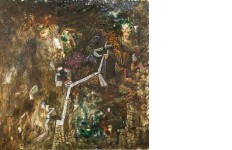Γλυπτική 15Σχέδιο 72Ελαιογραφία 74Τέμπερα 5Μικτή Τεχνική 30Υδατογραφία 15Χαρακτική 6Ακρυλικά 9Gouache 5Αυγοτέμπερα 2
Ειδικές Πληροφορίες για τον Καλλιτέχνη
TITΛΟΣ ΕΡΓΟΥWall across dark rocks
ΔΙΑΣΤΑΣΕΙΣ ΕΡΓΟΥΎψος : 56
Πλάτος : 56
ΥΛΙΚΟ ΚΑΤΑΣΚΕΥΗΣΕλαιογραφία (Λάδι σε χαρτόνι)
ΥΠΟΓΡΑΦΗ ΚΑΛΛΙΤΕΧΝΗΚάτω Δεξιά
ΧΡΟΝΟΛΟΓΗΣΗ01-01-1957
ΕΛΕΓΧΟΣ ΓΝΗΣΙΟΤΗΤΑΣΔεν έχει ελεγχθεί

Footnotes
Painted in 1957.
Provenance
Alexander Iolas Collection, New York.
Tassos Zoumboulakis Gallery.
Private collection, Athens.
Exhibited
Paris, Galerie des Cahiers D'Art, Ghika, February 25 - March 18, 1958.
New York, Alexander Iolas Gallery, Ghika, April 15 - May 3, 1958.
Athens, National Gallery - A. Soutzos Museum, Ghika, May 1973 (possibly listed in the exhibition catalogue, no. 71).
Literature
Ghika, Paintings, Drawings, Sculpture, Boston Book and Art Shop, Boston 1964, pl. 96 (illustrated).
Ghika. Peintures, dessins, sculptures, Cahiers d' Art, Paris 1965, fig. 11.
H. Livas, Contemporary Greek Artists, Vantage Press, New York, 1993, p. 10 (referred).
N. Hadjikyriakos Ghika, The Apollonian, the Dionysian 1906-1994, exhibition catalogue, Athens 2006, no. 71, p. 51 (illustrated).
K.C. Valkana, Nikos Hadjikyriakos-Ghika, His Painting Oeuvre, Benaki Museum edition, Athens 2011, no. 258, p. 291 (illustrated).
Featuring prominently across the picture plane, the crooked stone walls that inform so much of the Greek insular landscape and rank among the painter's signature subjects, emerge like ancient ruins from a rocky landscape captured in bold colours and vigorous brushstrokes. In an attempt to delve into the artist's temperament, writer C. Zervos noted: "Deliberately confined in his solitude, Ghika felt the need to harmonise the dispositions of his inner life with the fictitious images to which he sought to give convincing existence. The barriers he raised to shut himself in explain why walls became one of the recurring features of his iconographic repertory."1
Art critic H. Livas, however, takes another view on the matter: "True, walls have been a significant feature in Ghika's works, the 1957 Walls across rocks being an example, but I suspect this is less for psychological reasons and more a reflection of Greece's reality. One cannot look at a field or slope without seeing stone walls. They are erected by the farmers, stones put in place by hand, to mark off their property. Walls also surround houses and estates to keep out the dust from unpaved streets and to provide privacy and protection."2
1. C. Zervos, "Ghika and his Art" in Ghika, Paintings, Drawings, Sculpture, Boston Book and Art Shop, Boston 1965, p. 5. See also N.Kyriazi, Ghika Landscapes and Interiors, exh. cat., Municipal Gallery of Athens, Athens 2006, p.17.
2. H. Livas, Contemporary Greek Artists, Vantage Press, New York, 1993, p. 10.